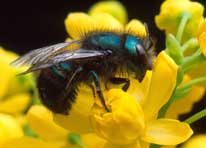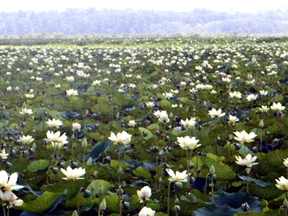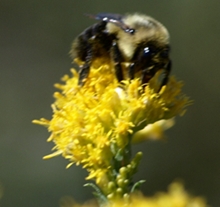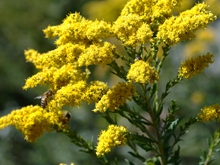- The Orchard Mason Bee -
Clues To Their Gentle Nature
Introduction to the World of Mason Bees

Learning the life cycle of the orchard mason bee will provide numerous insights for raising and attracting these incredible bees. This super-friendly bee is the most industrious bee you possibly never heard of, until now. We're going to fix that right here. It is important to learn the life cycle of orchard bees to care for them properly.
To attract orchard bees require three important elements from us and nature. March is the time the spring blooms appear, so the last two things should be in place by that time in most areas:
- Spring blossoms.
- A suitable bee house.
- A supply of available mud.
You will see how these three things fit together by reading the orchard mason bee life cycle below.

North America has approximately 4000 species of native bees with mason bees are at the top of the list. They
are many times more effective at pollination than honey bees. I am sure
you have seen them many times, but just didn't know what they were. Native bees excel at pollinating native plant varieties. (Photo Shows Flowering Lily Pads in Louisiana Swamp / By Russ James)
When people see them they often don't realize they are bees. Rather large black or blue flies come to mind, since some think they appear more like flies than bees. Most importantly, you can attract these totally non-aggressive bees to your garden or orchard. More than that, you can even provide a house for them and keep them in your yard year after year.
Native bees are everywhere across the country. In the U.S., they can be found from the deep South extending north into Canada, from Florida to California. Every country across the globe has native solitary bees.

This is an important note:
Do you have a fear of bees? This is great news then. Don't worry about
being stung. Unlike honey bees that have a reputation of stinging in defense of the hive, the
mason bees are not aggressive at all. They are so very gentle. Solitary bees get along great with other bee species working together without conflict.
(Bumble Bee on Wild Flowers / Russ James)
Being
solitary bees, they have no hive to defend. They will not attack, chase
you, or swarm. Only the female is capable of stinging, but rarely does.
You really have to work at getting this bee to sting. Here's more good
news: The female's "stinger" is actually her egg tube, so there is no
venom injected and the sting feels much like a mosquito bite or similar
to a biting fly. Most people who works with orchard mason bees have
never been stung.
Out in nature, orchard mason bees live in tunnels left behind by wood boring insects. Since they cannot bore their own tunnels, they are always looking for an available nesting site.
Therefore, all you need to attract mason bees is to have an available food source (flowers/blossoms) and a "bee house" set up for them. The most common house is a block of wood with drilled holes that the bees can use. But first let's look at the life cycle of this amazing bee.
The Orchard Mason Bee Life Cycle
A Basic Life Cycle Overview
There is only one generation of orchard mason bee per year. The life of a bee begins each spring when a young bee emerges from a nesting tunnel. The perfect tunnel is 5/16 inch in diameter and at least 6 inches long.
Inside this tunnel, just before spring emergence, there is about 5 or 6 cocoons containing a full grown mason bee waiting for the perfect time to emerge. Each cocoon in the tunnel is separated from each other by a thin mud wall placed there by the adult mother mason bee the spring before. The outside end of each tunnel is capped with a thick plug of mud. Here's how all this happens.
Here We Go - Starting with Spring Emergence
Let's begin their life cycle starting with the spring emergence. As soon as the spring temperatures reach 55 degrees for a few consecutive days, the first orchard mason bees begin chewing through the cocoon and progresses through the outer mud plug. The first few bees in the nesting tunnel closest to the entrance are always males. The last two or three bees deeper in the tunnel are females.
(Hence, the importance of at least a six inch tunnel. If the tunnel is too short, there will be only male bees. The tunnel can be longer than six inches, but six is good.)
The male bees emerge first. It is always this way. After emerging they take some time to adjust to the cool air and then start flying to blossoms and plants to feed on nectar, then fly right back to the nest. This is repeated over and over. Why back to the nest? They are waiting patiently for the females to emerge.
Anywhere from a few days to a couple weeks the females finally emerge and are immediately pounced upon by waiting males. The females have not even had time to acclamate to the outside air and are still not ready to fly. This is all part of the design and ensures the females will be mated.
It is common to see a ball of two or three orchard mason bees swirling around on the ground as they go through the mating process. One female with a couple males battling for his turn to mate. Each female may mate with several male orchard mason bees in just a few days. Once all females are mated, the male has completed his role and dies. His life lasts but a few days.
From This Point Forward, It is a Totally Female Mason Bee World
Now, with mating complete, all the males bees are dead. The female flies off to blossoms to feed upon the sweet nectar. In the process they begin loading the tiny hairs on their body with pollen. Each flower they land on releases some pollen and pollinates the plants. It is estimated that 95 percent of the blossoms they land on are effectively pollinated compared to only 5 percent by honey bees. Keep in mind though, it may still take several bees landing on a blossom for full pollination.
When the female bees have had their inital fill of nectar, they begin looking for a tunnel of their own. They will often go back to the same hole they were born in. Hint: If you have put up a mason bee house, they will have a ready home to begin the next generation of bees.
The Female Begins Her Own Future Generation of Bees
After finding a suitable nesting site, the orchard mason bees looks for mud containing the precise ratio of clay and other elements and carries some back to the tunnel. She starts building a mud wall in the back of the tunnel.
This Explains Why They Are Such Great Pollinators

Visiting Blossom after blossom, hundreds upon hundreds of delicate blooms, is the means of accomplishing her goal - to produce the next generation. Here's how.
With the back wall complete, she again gathers more pollen and nectar. Entering the tunnel she proceeds to the back mud wall, scrapes off the pollen from her body and regurgitates some nectar to make a sticky pollen/nectar pile. This process is repeated several times creating layer upon layer until the pollen/nectar pile is complete. The female orchard mason bee then backs into the tunnel and lays an egg atop the pollen mix. This is the food for the future bee larva. The sticky nectar holds the egg fast and firm.
When the egg is fixed onto the pile, the mother orchard mason bee builds a thin mud wall and seals off the egg. She does the same again until the tunnel is filled with several cells containing a single egg atop a pollen mix. When she reaches the outside, she creates a mud end cap and seals off the entire tunnel. She immediately looks for another tunnel to start again until all the tunnels are complete or when she runs out of eggs.
The Female Determines the Sex of Each Egg
This is fascinating. The female actually determines the sex of each egg, leaving nothing to chance. After mating, the male sperm is stored in a special compartment within the female. When an egg passes through the tube, the female decides if some sperm will be released to the egg or not. If the sperm is withheld, the bee will be a male. Fertilized eggs will be females.
Therefore, the eggs planted in the back part of the tunnel will be fertilized to become females. The front half of the tunnel will contain males. This is done intentionally. Woodpeckers or other predators that penetrate the outer plug will kill or eat the male bees first and the female bees farther back are often spared. This is because they really don't need many males. One male bee can mate with several females, so this process of sacraficing males ensures the survival of future generations. So by creating more males than needed, some males can be sacrificed without harm to future generations.
How the Eggs Develop Inside the Cell
The eggs hatches into a larva and begins eating the sticky mix of pollen and nectar inside the cell. The amount of pollen mix the female gathered will determine the size of the emerging bee next spring. Large pollen piles equal larger bees.
When the pollen mix is completely eaten, the larva spins a cocoon. Inside the cocoon the larva slowly changes into a bee. Once the metamorphosis is complete, the cocoon will sit motionless until the following spring when the temperatures rise triggering the bees to emerge.
Here is Where You Come In - The Fun Part!
Orchard mason bees can use our help. They have many enemies, including various parasitic wasps and mites that reduce their numbers.
If you have a bee house, you can remove the cocoons, clean them, and place them in a cool place till spring when it is time to put them out again. Don't worry, these cocoons are very, very tough.
The clean cocoons are sealed in a container and placed in an unheated shop or garage all winter. Some people put them in the crisper drawer inside the refrigerator. The cold temperatures keep them in hibernation for as long as needed.
In the spring, put the cocoons near the bee house. They will emerge and begin using the bee house for the next generation. Don't worry, I will explain how to remove and clean cocoons in a separate article.
This is also important: Providing flowers or blossoms is essential to keeping the bees in your yard. They do not like to fly more than a hundred yards from the nesting house. However, if you have no flowering trees or blooming plants available they will look for them elsewhere. Once they find a food source they will look for a nesting site near to the food. To keep them in your yard, you need to have a food source ready when they emerge. This means blooming plants.
Solitary Bee Pollination vs Honeybee Pollination
Both honeybees and solitary bees are extremely important to life on earth. Up to 85% of pollination occurs with bees. Learn the secrets of how plants are pollinated and why keeping solitary bees are important for all of us.
Protecting Your Bees From Pollen Mites
Pollen mites can harm your bees. If you harvest your mason bee cocoons (and you should), learn how to remove mites from bee cocoons to ensure a good spring emergence.
Mason Bee Life Cycle to Mason Bee Landing Page
Orchard Mason Bee Life Cycle to Lawn Care Academy Home
